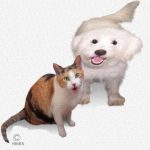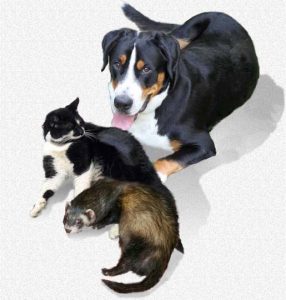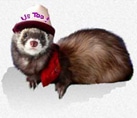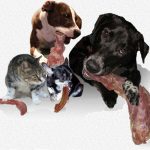Dental Hygiene – Caring For Your Dog And Cat’s Teeth – Periodontal Disease
Ron Hines DVM PhD
This is an older article
 Read a better and more extensive one here
Read a better and more extensive one here
All cats and dogs eventually face minor or major dental issues. Some of that is just the effect of time; but a lot has to do with the soft diets we often feed them. Some of it, particularly in dogs, has to do with their breed genetics – the mouth and face conformation we breed for. Also, their wild ancestors rarely lived long enough to face dental issues and when they did, it was often their undoing. Us humans face enamel decay and cavities. Cavities are quite rare in dogs and tooth resorption is the closest thing that cats face. Read more about that at the bottom. What dogs and cats face is gum recession that exposes the softer root portions of their teeth. The rough surfaces of that lower portion material (cementum) allows bacteria to prosper in the area surrounding the tooth root. (read here) With time the inflammation this infection produces causes the gums to recede and loosens the tooth. Fluids that ooze from the area become the basis for heavy, mineralized tartar. That process leads to strong breath, drooling and discomfort. This chronic infection has other, less evident consequences. Many veterinarians suspect that these bacteria and their products can enter the pet’s blood stream and lodge in the pet’s kidneys, heart and liver where they also cause damage. (read here)
When veterinarians are presented with a dog or cat with a strong mouth odor, the first step is an oral examination. The gums of these pets tend to bleed easily. Hard, yellow tartar usually surrounds the tooth necks and base of the teeth. That is particularly obvious on the cheek side of their molar teeth. Often one side of the mouth is more affected than the other due to the pet’s chewing habits. Dental disease is a two-way street. It can be the cause of systemic (body wide) illness, or it can be the result of systemic illness. So, it is wise to have your veterinarian run or order a general health screening and perform a complete physical examination – even when your cat or dog was presented for a teeth cleaning. Besides, most veterinarians utilize general anesthetics when performing dental cleanings, and it is never a wise idea to administer anesthetics to a pets whose general health is an open issue.
Feline Immunodeficiency virus can lower your cat’s ability to fight infections and gum disease. So, a test for feline immunodeficiency virus might be suggested when gum disease and halitosis are present in a younger cat. Dental disease is also more common in certain breeds of cats and in the toy dog breeds. Siamese and Persian cats as well as Maltese, toy poodles and Yorkshire terriers are particularly prone to tartar accumulation and receding gums. That is most likely due to a combination of their genetics, their taste for table scraps and canned diet, and their owner’s willingness to provide them.
Immature Dogs And Cats:
Puppies and kittens often develop a strong mouth odor while they are teething. They may run a fever as well. This is a natural phenomenon. One can purchase a benzocaine-containing medication for teething infants and massage it on to the puppy or kittens sore loose teeth. In some puppies and occasionally in kittens, the milk canine teeth (temporary teeth or fangs) of the upper jaw and occasionally the lower jaw are not shed properly. This results in the permanent teeth sprouting behind or next to the temporary teeth. Milk teeth have very short roots and can be easily removed by your veterinarian. Often that is done at the same time the pets are anesthetized to be spayed or neutered. When puppy or kitten teeth erupt (come in) discolored, it is usually due to the poor nutritional status of their mother. Less commonly, teeth are discolored due to the pet or the mother received one of the tetracycline antibiotics during or just after pregnancy or when certain drugs were given to the young pet. Drugs that will discolor teeth include tetracycline, oxytetracycline and chlortetracycline. Doxycycline is probably safe to give to young pets. (read here) But when giving doxycycline to cats, I prefer that it be in liquid form. The drug in pill or capsule form has been known to lodge and cause esophageal damage in cats. (read here)
Malocclusions (Misaligned teeth)
In addition to retained puppy fangs and teeth broken in accidents, the most common dental problems many veterinarians see in younger pets are due to misaligned teeth or malocclusion. This problem is particularly common in dogs and cats with flat faces. Often their lower jaw protrudes far beyond the upper one, so that the anterior teeth of the lower and upper jaws do not touch. In long-snouted breeds (dolichocephalic dogs) when similar problems occur, it is usually the upper jaw that protrudes past the lower. It is not a painful condition, but I suggest that dogs with a severe overbite not be bred if it is not acceptable in their breed standard. Even though the lower fangs may erode the pet’s upper gums initially, the teeth often slowly shift on their own, halting the irritation. No need to rush into orthodontics unless pain or infection is involved. When it does not resolve with maturity, there are veterinary dental specialists who can improve the situation.
What Can I Do About The Soft Food Problem?
Leaving bad breath aside, dental problems can lead to more serious health issues in your pet. As I mentioned earlier, plaque and inflammation allow bacteria easier access to all parts of the pet’s body. Your pet’s immune system will mount a perimeter defense around the infected tissue in your pet’s mouth, but that defense is not foolproof. (read here & here) Canned food causes more of a problem than dry kibble, but neither correspond to what a dog or a cat was designed to eat. Chew toys are accepted by some pet but not by others. Brushing your pet’s teeth is quite helpful, but most pet owners and some pets find it bothersome. Appropriate fresh chew bones give excellent results but are feared by some owners and veterinarians. Vets only see the few pets that gulped them down. When one elects to give them, it is best started at a young age (my favorite are cow and pig tracheas, ears and snouts because they do not wear teeth down over the years, but they can be hard to obtain). Traditional Milkbones™ and similar treats do little or nothing to address this problem. But within the last few years, a number of companies have developed heat and injection pressure-molding processes that produce flavorful, digestible treats that are hard enough to keep a pet’s teeth clean. Most have a high content of cross-linked (“beaded”) potato starch. Some contain similarly processed corn starch and calcium carbonate. They are safely digested. One of the new ones, Milkbone’s “Brushing Chews” for example, contain rice flour, modified food starch and chicken by-product meal as their first three ingredients.
Several manufacturers produce “dental diets” Some contain more abrasive kibble, other enzymes said to dissolve plaque. All are of limited effectiveness. I do not recommend rawhide or processed bones because there have been too many instances of toxic materials entering the manufacturing process. I also have little faith in the effectiveness of sprays and mists that claim to reduce tartar accumulation.
Brushing Your Dog And Cat’s Teeth
Dry food and chew aids help, but they do not entirely remove tartar at the gum line where dental problems begin. Using a soft, pediatric toothbrush or finger brush and toothpaste especially designed for dogs and cats will help prevent dental disease. Most dogs, cats and ferrets accept the taste of these toothpastes readily. Cats are not naturally fond of having their teeth brushed, so it is important to start their tooth brushing routine between 3-6 months of age. Most pets dislike human toothpaste. Do not use it on them. Start by simply massaging your pet’s lips and mouth with your fingers – then give a treat. When your pet is comfortable with that, get them accustomed to having their lips and teeth rubbed. Then place a little of the toothpaste on your fingers as you do this. If you are fastidious, wear a finger cot. Most of the tartar (80%) forms on the outer (= buccal = cheek side) surface of the teeth, so you do not need to spend nearly as much time cleaning the inner surfaces. Concentrate on the rear teeth and the base of the canine teeth (fangs). Begin brushing for very short periods; very gently and very slowly. When you are done, give your pet a treat for being a good patient. Proceed longer and more thoroughly gradually from day to day and stop when your pet begins to squirm or show annoyance. Within a few weeks, you should be able to do a rather thorough job. Some pets by nature resent tooth brushing more than others. Obstinate or fearful pets will have to rely more on veterinary hospital cleaning and therapeutic dental chews.
Professional Teeth Cleaning
Any cosmetic dental procedure that is available for humans is available for pets – usually performed by veterinarians who do nothing else. I rarely send clients to them for fillings, crowns or implants. When I do, it is generally for repair or replacement of a canine tooth broken off through trauma. I have not observed that dogs or cats with multiple or total tooth extractions lead any less happy lives than those who go to dental specialty clinics for complicated dental restorations. Dogs and cats do not contemplate their appearance in the mirror as we do. When a pet looses one of its bottom canine teeth, its tongue will usually protrudes outward on the same side. That does give them a comical appearance that might offend some pet owner’s sensibilities. But it causes them no pain, self-consciousness or discomfort. Although many pets can have their teeth well-cleaned without general anesthesia just as you do, professional veterinary dental associations now frown on that. Many dogs and cats that are not naturally calm enough need no more than moderate tranquilization. That too is now frowned upon by these same organizations. General anesthesia is never without risk. I have never felt that it was warranted when it was not necessary.
The frequency that pets need preventive dental cleaning (prophylaxis) varies between pets based on their diet, their age and the amount of gum recession that has already occurred. Despite removal of tartar and treatments to decrease gum infection; in advanced periodontal disease, receded gum lines never regrow as far up the tooth as they once reached. So, tartar removal in pets with advanced dental disease might have to be performed quite often. At some point, it will be better for your pet’s general health to just remove severely affected teeth.
Feline Odontoclastic Resorptive Lesions
Some cats, particularly Siamese and Persians suffer from tooth root reabsorption. The reasons for that remain unknown. We believe that this problem is painful to the cat because they tend to eat gingerly and often lose weight. These teeth will eventually break off. I believe that the kindest thing you can do for a cat with this problem is to have all affected teeth extracted. You can read more about this disease here. It appears to be more common in cats that carry the feline immunodeficiency virus. (read here). The disease has also been associated with excessive vitamin D3 consumption and too acidic an oral environment. (read here) There are more specific articles than that one, but they are all paywall. protected.
You are on the Vetspace animal health website
Visiting the products that you see displayed on this website help pay the cost of keeping these articles on the Internet.



